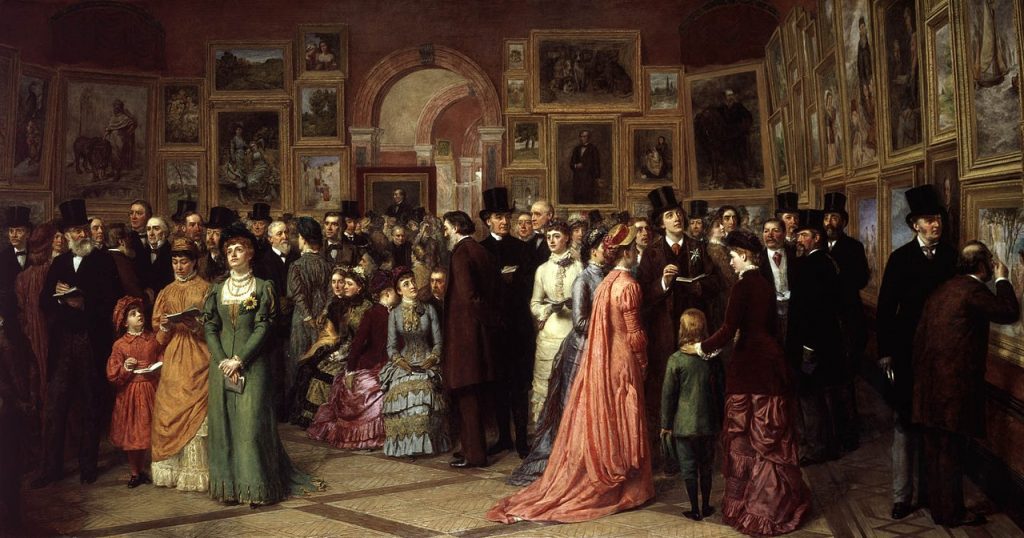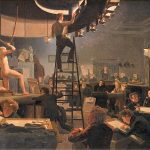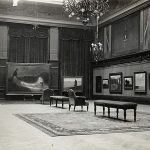
The Royal Academy of Arts (RA) is a cornerstone of British culture and creativity, representing centuries of artistic excellence and tradition. Founded in 1768, the RA has profoundly shaped the trajectory of British art, acting as both a training ground for artists and a prominent public exhibition space. This esteemed institution has played a central role in fostering artistic talent, championing academic rigor, and nurturing public appreciation of the arts. Over its long history, the RA has remained dedicated to its mission of advancing the fine arts of painting, sculpture, and architecture.
Throughout its history, the RA has been instrumental in elevating the status of artists within British society. It introduced innovative approaches to art education and established platforms like the Summer Exhibition, which provided opportunities for artists to gain public recognition. These contributions have cemented its reputation as a vital institution in the global art world. The RA has not only shaped individual artists’ careers but also contributed significantly to the cultural fabric of Britain. This legacy continues to inspire admiration and respect for the arts across the nation and beyond.
This article will take readers on a journey through the history and significance of the Royal Academy. From its founding during the Age of Enlightenment to its dynamic evolution through the Victorian era and into the modern age, we will explore its key milestones and lasting impact. Along the way, we’ll examine its most influential members, its global reach, and the challenges it has overcome to remain relevant in an ever-changing world. Together, these aspects provide a comprehensive picture of the RA’s enduring role as Britain’s gateway to artistic excellence.
Through its unwavering commitment to tradition and innovation, the Royal Academy has become a symbol of artistic achievement and resilience. By examining its origins, growth, and influence, we can better understand how it has left an indelible mark on British culture. This exploration will not only celebrate its achievements but also reflect on its continued relevance in shaping the future of art and creativity. Let us delve into the fascinating story of the RA, a testament to the power of art to inspire and transform society.
Founding of the Royal Academy (1768)
The Royal Academy of Arts was founded in 1768 under the patronage of King George III, marking a pivotal moment in British cultural history. Inspired by the success of European art academies, the RA was established to elevate the status of artists and promote the fine arts in Britain. Its founding charter emphasized the cultivation of painting, sculpture, and architecture, aiming to position British art on par with its continental counterparts. This mission reflected broader Enlightenment ideals, highlighting the belief in education and cultural advancement as essential components of national identity.
The Academy’s early leadership included some of the most celebrated artists of the time, with Sir Joshua Reynolds serving as its first president. Reynolds was a staunch advocate for academic rigor and intellectual engagement in art, emphasizing the importance of historical themes and moral instruction in artistic expression. Among the other founding members were Thomas Gainsborough, known for his masterful portraits, and Angelica Kauffman, one of the few women artists of her era to achieve prominence. These individuals brought diverse perspectives and talents, laying a strong foundation for the Academy’s enduring influence.
Despite its lofty ambitions, the RA faced significant challenges in its early years. It had to compete with existing organizations like the Society of Artists of Great Britain, which already held a strong foothold in the art community. Securing funding and public support was another hurdle, as the Academy sought to establish its credibility as a premier institution. These obstacles underscored the difficulty of creating a lasting institution that could serve as both an educational hub and a cultural landmark.
One of the Royal Academy’s first major successes was the inauguration of the Summer Exhibition in 1769, a tradition that continues to this day. This annual event provided a vital platform for artists to showcase their work and connect with audiences. The exhibition quickly became a cultural highlight, attracting both critical acclaim and public enthusiasm. By bridging the gap between artists and society, the Summer Exhibition solidified the Academy’s role as a key player in Britain’s cultural and artistic development.
Evolution During the 19th Century
The 19th century was a transformative era for the Royal Academy, marked by significant growth and adaptation. Under Queen Victoria’s patronage, the RA became a prominent symbol of British cultural pride, aligning with the grandeur and values of the Victorian era. The Academy emphasized history painting, portraiture, and classical themes, which resonated with the tastes of the time. This focus on traditional subjects reflected a desire to preserve cultural ideals while celebrating Britain’s growing influence on the global stage.
One of the Academy’s most enduring contributions during this period was the expansion of the RA Schools. This institution became a rigorous training ground for emerging artists, providing them with the technical and theoretical skills needed to excel. The curriculum emphasized life drawing, anatomy, and perspective, ensuring a high level of craftsmanship among its students. Prestigious awards such as the gold and silver medals motivated artists to strive for excellence, solidifying the RA Schools’ reputation as a leading institution for art education.
In 1868, the Royal Academy relocated to Burlington House in Piccadilly, a move that marked a new chapter in its history. The building’s grandeur and central location made it an iconic symbol of the Academy’s prestige and cultural importance. Burlington House also provided a dedicated space for exhibitions and educational activities, enhancing the Academy’s ability to engage with the public. This architectural milestone reflected the RA’s commitment to both tradition and innovation as it adapted to the changing needs of the art world.
Despite its successes, the RA faced criticism during the 19th century for its conservative approach to art. The rise of movements such as Pre-Raphaelitism and Impressionism challenged the Academy’s traditional values, leading to tensions within the art community. These modern movements sought to break free from academic conventions, emphasizing innovation and individual expression. While the RA resisted these changes, the debates ultimately enriched the artistic landscape and underscored the dynamic nature of art in Victorian Britain.
Famous Artists and Alumni
The Royal Academy has been home to many of Britain’s most celebrated artists, whose works have shaped the nation’s artistic heritage. Among the founding members, Sir Joshua Reynolds stands out for his contributions to the “Grand Manner” style, which emphasized idealized, historical themes. Thomas Gainsborough, another founding member, gained acclaim for his elegant portraits and landscapes, which captured the grace and refinement of his subjects. Angelica Kauffman, one of the first women admitted to the RA, defied societal norms and became a trailblazer in the male-dominated art world.
The Victorian era produced legendary figures such as J.M.W. Turner and John Constable, both of whom were deeply influenced by their time at the Academy. Turner revolutionized landscape painting with his dramatic use of light and color, inspiring future generations of Impressionists. Constable, in contrast, focused on naturalistic depictions of the English countryside, emphasizing the beauty of everyday scenes. Their works elevated the status of landscape painting and cemented their places as icons of British art.
The Pre-Raphaelite Brotherhood, though critical of the RA’s traditionalism, had strong connections to the institution. Members such as Dante Gabriel Rossetti and John Everett Millais received training at the RA Schools, where they honed their technical skills. While their rejection of academic norms caused controversy, their innovative approach to art left a lasting impact on the artistic community. This interplay between rebellion and tradition highlights the Academy’s complex role in shaping British art.
In the 20th century, the RA continued to nurture influential artists such as Henry Moore, Barbara Hepworth, and David Hockney. Moore and Hepworth pushed the boundaries of sculpture, embracing modernist aesthetics and abstraction, while Hockney’s vibrant pop art reflected the cultural shifts of his era. The contributions of these artists demonstrate the Academy’s ability to adapt and evolve, fostering talent that transcends conventional boundaries. Through their groundbreaking work, they ensured the RA’s relevance in the modern art world.
The Royal Academy’s Global Influence
The Royal Academy’s influence extends far beyond Britain, shaping the global art world through its traditions and achievements. As a symbol of national pride, the RA contributed to cultural diplomacy by promoting British art and architecture across the empire. Its exhibitions and educational programs inspired similar institutions in other countries, particularly in former British colonies. This international reach reinforced the Academy’s role as a leader in the fine arts, spreading its values and techniques worldwide.
The RA’s academic traditions, particularly its focus on technical excellence, became a model for art institutions globally. Schools in Europe, the Americas, and Asia adopted its rigorous methods, emphasizing foundational skills such as drawing and composition. This legacy is evident in the curriculum of many prestigious art schools, which continue to draw inspiration from the RA’s standards. By exporting its educational principles, the Academy played a crucial role in shaping the development of global art education.
The RA also influenced the spread of academic and classical art styles, particularly during the 19th and early 20th centuries. Its emphasis on historical and moral themes resonated with audiences across Europe and the Americas, contributing to the popularity of traditional art. While modernist movements eventually challenged these ideals, the RA’s impact remained significant as a counterpoint to avant-garde trends. This tension between traditionalism and innovation has been a defining feature of the global art narrative.
In addition to its educational and stylistic influence, the RA’s exhibitions have showcased British art on an international stage. These events have attracted artists and audiences from around the world, fostering cross-cultural exchange and dialogue. By bringing diverse perspectives together, the Academy has reinforced its status as a global hub for artistic excellence. This enduring influence highlights the RA’s ability to transcend national boundaries and inspire creativity on a worldwide scale.
Challenges and Modernization in the 20th Century
The 20th century brought significant challenges for the Royal Academy as it faced the rise of modern art movements. Avant-garde styles such as Cubism, Surrealism, and Abstract Expressionism rejected traditional academic principles, challenging the RA’s authority in the art world. This shift in artistic values led to a decline in the Academy’s influence, as many artists and critics viewed it as overly conservative. The Summer Exhibition, once a highlight of the cultural calendar, struggled to maintain its relevance in a rapidly changing art market.
In response to these challenges, the Academy undertook a series of institutional reforms to modernize its approach. By the mid-20th century, it began incorporating contemporary art into its curriculum and exhibitions, embracing innovation while maintaining its commitment to technical excellence. These changes reflected a growing recognition of the need to engage with new artistic trends. The inclusion of modern and experimental works helped the RA reconnect with younger artists and audiences, revitalizing its role in the art world.
The RA also sought to expand its public outreach, making art more accessible to a broader audience. Workshops, lectures, and educational programs were introduced to engage with the general public and foster a deeper appreciation for the arts. Digital initiatives further enhanced accessibility, allowing people from all walks of life to explore the Academy’s offerings. These efforts underscored the RA’s commitment to remaining a relevant and inclusive institution in the modern era.
Despite these advancements, the Academy faced ongoing criticism for its perceived elitism and slow pace of change. Debates about its role in the contemporary art world highlighted the tension between tradition and innovation. However, these critiques ultimately strengthened the RA by prompting self-reflection and adaptation. Through its resilience and willingness to evolve, the Academy has maintained its status as a cornerstone of artistic excellence.
The Royal Academy Today
Today, the Royal Academy stands as a dynamic cultural hub, blending tradition and innovation to engage with contemporary audiences. Its mission remains rooted in the advancement of the fine arts, but its approach has evolved to reflect the needs of a modern society. The RA continues to host world-class exhibitions, showcasing works from historic masters and contemporary innovators alike. These events draw visitors from around the globe, reinforcing the Academy’s reputation as a leading institution in the art world.
The RA Schools remain a vital part of the Academy, offering a rigorous yet forward-thinking curriculum. Students are encouraged to explore both classical techniques and modern approaches, fostering a well-rounded artistic education. This blend of tradition and experimentation ensures that graduates are prepared to navigate the complexities of the contemporary art scene. By nurturing the next generation of artists, the RA Schools uphold the Academy’s legacy of excellence in art education.
The Summer Exhibition remains a cornerstone of the RA’s annual program, adapting to contemporary tastes while honoring its historical significance. This event continues to provide a platform for artists of all backgrounds, celebrating the diversity and vibrancy of the art community. In addition to the Summer Exhibition, the RA hosts special exhibitions that delve into the works of iconic figures like Turner and Hockney, drawing connections between past and present. These initiatives highlight the Academy’s commitment to fostering dialogue between different eras and styles.
Public outreach has become a central focus of the RA’s mission, with programs designed to engage people of all ages and backgrounds. Community partnerships, school collaborations, and interactive workshops aim to make art accessible and enjoyable for everyone. Digital platforms have further expanded the Academy’s reach, allowing global audiences to experience its offerings. Through these efforts, the RA continues to inspire and connect with people, ensuring its relevance for generations to come.
Legacy of the Royal Academy of Arts
The Royal Academy’s legacy is one of profound cultural and artistic impact, spanning more than 250 years. Its contributions to British art and culture have shaped the nation’s identity, fostering a deep appreciation for the fine arts. As both a training ground for artists and a public institution, the RA has played a dual role in advancing creativity and connecting art with society. This enduring legacy underscores the Academy’s importance as a pillar of Britain’s cultural heritage.
Generations of artists and architects have benefited from the RA’s rigorous training and mentorship, leaving an indelible mark on the global art world. The Academy’s emphasis on foundational techniques and intellectual engagement has influenced countless creative minds, ensuring the preservation of artistic traditions. At the same time, its willingness to adapt and evolve has allowed it to remain relevant in an ever-changing cultural landscape. This balance between tradition and innovation is a hallmark of the RA’s enduring success.
Despite its achievements, the RA has faced criticism for its conservative practices and exclusionary tendencies. These controversies have sparked important debates about the role of art institutions in society, prompting the Academy to reflect and reform. By addressing these challenges, the RA has demonstrated its resilience and commitment to growth. These ongoing efforts ensure that the Academy remains a vital and inclusive space for artistic expression.
Looking to the future, the Royal Academy continues to inspire and educate, embracing its role as a beacon of artistic excellence. Its ability to adapt to new trends and engage with diverse audiences ensures its continued relevance in the contemporary art world. By honoring its rich history while looking forward, the RA remains a testament to the transformative power of art. Its legacy serves as a reminder of the importance of creativity in shaping the world around us.
Conclusion
The Royal Academy of Arts is a cornerstone of British culture, embodying centuries of artistic achievement and innovation. From its founding in 1768 to its modern-day influence, the RA has played a pivotal role in shaping the artistic landscape of Britain and beyond. Its commitment to advancing the fine arts through education, exhibitions, and public engagement has cemented its place as a vital cultural institution. The Academy’s ability to balance tradition and innovation has been key to its enduring success.
As a training ground for generations of artists and architects, the RA has had a profound impact on the global art world. Its rigorous curriculum and emphasis on technical excellence have influenced countless creative minds, while its public programs have inspired admiration and appreciation for the arts. The Academy’s legacy is one of resilience and adaptability, reflecting its commitment to fostering creativity and cultural dialogue. This rich history continues to shape its vision for the future.
In reflecting on the RA’s journey, it is clear that its significance extends far beyond the boundaries of Britain. Its contributions to art education, exhibition, and public engagement have left an indelible mark on the global stage. As the Academy moves forward, it remains a beacon of artistic excellence, championing the transformative power of creativity. The story of the Royal Academy is a testament to the enduring importance of art in enriching our lives and shaping our collective identity.
Key Takeaways
- The Royal Academy of Arts was founded in 1768 to advance painting, sculpture, and architecture in Britain.
- Its Summer Exhibition remains a vital platform for artists, celebrating tradition and contemporary talent.
- Renowned alumni include J.M.W. Turner, Henry Moore, and David Hockney, among others.
- The RA Schools continue to provide rigorous training, blending classical techniques with modern approaches.
- The Academy’s public programs and global influence ensure its ongoing relevance in the art world.
FAQs
1. What is the Royal Academy of Arts?
The RA is a prestigious British institution dedicated to promoting painting, sculpture, and architecture through education, exhibitions, and public outreach.
2. Who founded the Royal Academy of Arts?
It was founded in 1768 under King George III’s patronage, with Sir Joshua Reynolds serving as its first president.
3. What is the RA’s Summer Exhibition?
The Summer Exhibition is an annual event showcasing works by artists of all levels, providing a platform for emerging and established talents.
4. What role do the RA Schools play?
The RA Schools offer a rigorous curriculum that combines classical training with contemporary techniques, preparing students for the modern art world.
5. How has the RA influenced global art?
The RA has shaped art education and exhibition practices worldwide, inspiring institutions in Europe, the Americas, and former British colonies.




